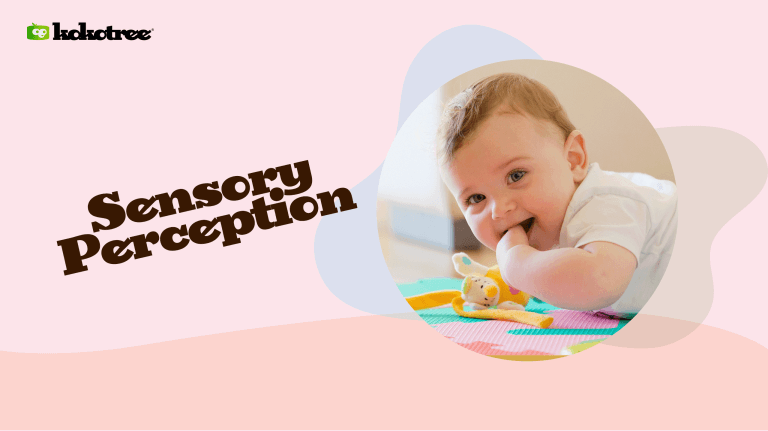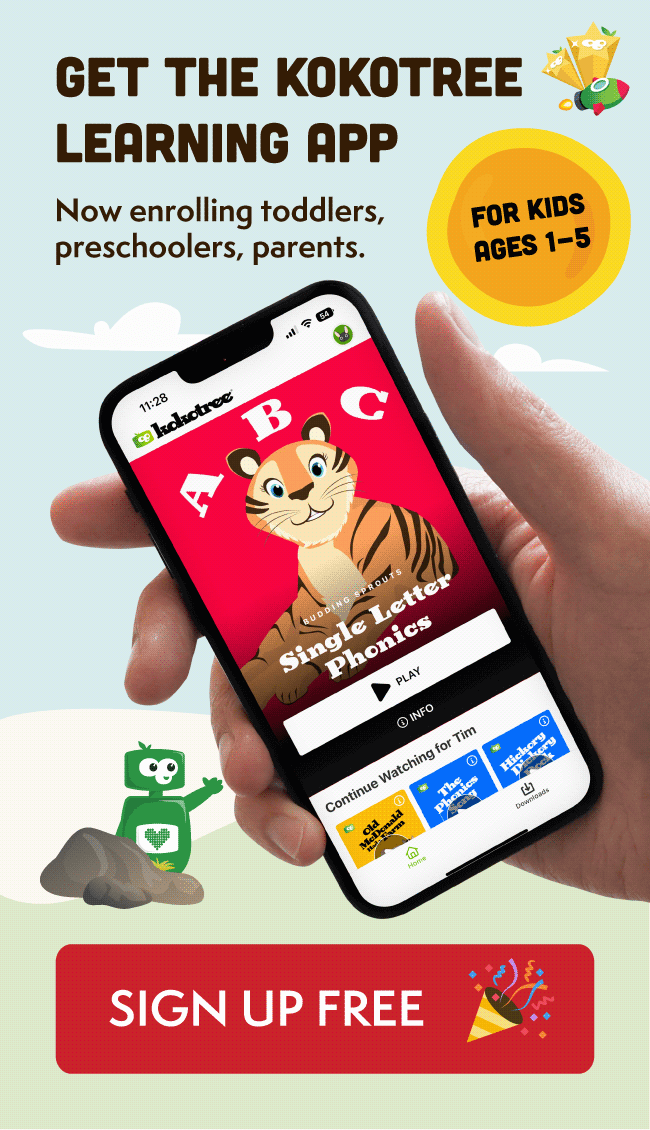

Ever wondered when infants recognize their mother’s touch, voice, or even her face? It doesn’t happen overnight the day they are born. Sensory perception is a gradual process of habituation that occurs over weeks, months, and years.
Children start learning to adapt to the environment right from the moment they are born. You probably know this already if you have an infant growing with you. But did you know that they gain information about the world through the sensory stimulations they receive? Simply put, children absorb the energy from their environment that connects them to it through their sensory systems.
Everything we humans do is discovered through some contribution from one or more of our senses, which is how infants gradually begin to unfold themselves to the world.
Sensory perception is when your child takes information from surroundings and tries to react accordingly. We can consider this as a two-step process. The first step is receiving data from the external environment through their senses or sensation, followed by interpreting the information obtained or perceived.
Sensory or Perceptual development is incomplete without either step and can delay or hinder your child’s cognitive development.
Infants start interacting with their surroundings as soon as they are born with the help of their senses. Warren R Bentzen, an author who observes young children, firmly believes infants learn by seeing, hearing, touching, tasting, and smelling.
These five senses of sight, hearing, touch, taste, and smell help your child form perceptions of the world and themselves.
Although perception is a process realized through an interaction of all senses, the sense of sight is the most powerful and effective compared to other senses. It accounts for 98% of infants’ learning.
The eyes are the most complex out of all our existing senses. With the help of this sense of sight, your infant can recognize objects and people around them, know where they are navigating, and receive and transfer information to the rest of their body.
For your child to have a good sense of sight, they must develop specific visual perceptions over time.

Get free parenting tips, news, updates, and content from Kokotree.
Depth Perception is the ability to perceive distance in objects. This is how your child measures and views the world and surroundings in three dimensions.
Activities where you can hold some objects of your child’s liking and keep moving them to notice how they move their vision can be an excellent exercise to improve fixation and visual focus.
Shape Perception is the ability to identify objects using their formation. This can help your child get familiar with objects in daily life.
Take your child’s toys and make them feel their shapes so they can familiarise themselves. As they grow, you can try this activity with fruits or vegetables they like to eat and use objects like pencils, toothbrushes, plates, bowls, and many others daily. Building blocks are a great way to acquaint your child with different shapes.
Colour Perception is the ability to recognize and differentiate colors. This will help your child discriminate objects using various colors.
You can take up activities like color blocks and flashcards to improve their awareness.
Children develop the sense of hearing better than the sense of sight at birth due to their time in the gestation period. According to a research study by Biological Basis of Behaviour, an infant can express a sense of music between 4 to 7 months and, by 12 months, will be able to differentiate between slightly different tunes.
The sense of hearing in an infant can be studied under four categories.
The ability to identify, compare and differentiate between distinct sounds is called auditory discrimination. It is vital in a child’s language development and reading skills.
Activities where the child can listen to similar sounding music notes or rhymes, or even words like play – pray, drink – blink, etc., and distinguish them from each other can help develop auditory discrimination within your child.
The ability to identify a sound and relate it to the source from which it is emitted develops early in childhood.
Activities, where your child can identify the sounds of different objects or sounds of other people around can be a great way of enhancing this ability in your child.
It is the ability to comprehend a sound or a set of sounds per order of sounds or words.
Activities involving listening to stories or rhymes work well in developing this ability in your child.
Auditory memory refers to grasping auditory information, processing it, preserving it in your mind, and recalling it when needed.
This auditory perception can progress when your child repeats words frequently used by you or tries to sing the rhymes that the child listens to repeatedly.
One of the first perceptions an infant develops post-conception is tactile perception involving the sense of touch. The fetus reacts to stimuli like temperature, pain, and pressure in the mother’s womb.
Studies suggest that infants need constant loving touch to grow emotionally. Sense of touch is transmitted chiefly using skin, especially hands. Tactile perception can be categorized broadly into-
The ability to physically identify objects based on features such as their shape, texture, softness, or volume depicts how sensitive your child is to touch and is well developed at the time of birth of a child.
Touch Matching refers to recognizing and identifying similarities or differentiating between different objects based on the sense of touch.
As we start feeding children different kinds of food, starting with milk and graduating to baby foods, we can notice their Gustatory Perception being activated. Infants initially use facial expressions and gestures to express their reactions to a particular taste. That is how you, as parents, can understand their taste preferences.
Infants generally resist foods that taste different or new from what they already know. Activities that can introduce children to different tastes before they switch to the original food item can assist a lot in developing their sense of taste.
Human beings have a keen sense of smell, which is almost 10,000 times more sensitive than the sense of taste. Infants react very strongly to smells. The first smell that an infant can identify is of their mother’s skin. Infants can start smelling from 14 weeks into the gestation period, which evolves further at birth.
Indulging in activities that can make your child differentiate the smell of the parents, grandparents, or siblings is the best way to enhance your child’s olfactory perception of objects.
You can create different pictures of objects and make them familiar with them before they start identifying them. You could use colorful flashcards, building blocks, and photos in the stories you read to your child or even draw them out yourself at times.
This could be a fantastic way of improving the sense of sight in your infant. Identifying the dots and connecting them to form a shape gives them a sense of accomplishment.
This activity will require your infant to use both their sense of sight and visual perception to recollect things from their memory. Start by showing them some objects familiar to them, preferably in pairs, and hide them in places where they can access them. All they have to do is to gather similar things—a fun way to see your infant grow.
According to many research scholars, children learn the most by hearing. Listening to stories is one of the best ways to learn things about the world around them. Grandparents or even Parents can tell them stories or read out stories to them as a regular activity. You can be creative and use the help of Books, Videos, and Audibles.
Well, nursery rhymes are non-negotiable!
Children love to listen to musical rhymes; before you know it, they start humming along and repeating the lyrics. Be it the traditional ‘Twinkle twinkle little star,’ the contemporary ‘Wheels of the bus,’ or ‘Baa Baa Black Sheep,’ they sure are a way to enhance your child’s hearing abilities while having fun.
Children get attracted to sounds, especially music in any form, from a very early stage. You can always start playing with your child watching and listening to you if you are a musical person. You will be surprised to see how well they can differentiate musical notes. Suppose you are not a musical person, no worries. You can always look up the internet or use help from various applications that can do the job for you.
During the early stages of infancy, babies prefer being held close to human skin. This helps make a bond with them and aids their emotional development. You can take up activities where you place objects on your palm and ask your child to get them from you. As they do so, they can feel the texture of different things on their skin. It is fun watching their expressions change as and when textures change.
Activities including paper crushing, paper cutting, playing dough, and finger painting can actuate the sense of touch of your child and make them familiar with their tactile perception.
Splashing hands in water, playing with objects in the water, and doing things that include making and touching bubbles are good sources of triggering the tactile perception in your child.
One of my childhood favorites is chewing gum. It sets on the taste buds and improves jaw movement too. Although it can become an addiction if it is not controlled correctly, it is one activity that can help your child’s taste buds.
As children grow old, most of them turn fussy when they have to eat healthy fruits and vegetables. That is mainly because they wish to avoid consuming things whose taste they need to be more familiar with. If you can make your infant taste all kinds of fruits in different forms, like flavored baby foods, fresh juices, or fresh fruit snacks that they can easily chew, this will help them become familiar with the different tastes, and chances of them being fussy might just come down.
It is often mentioned that sucking can have a calm and focusing impact on infants. Make your child suck different flavors of smoothies, juices, and shakes with a straw to strengthen their taste buds.
Take a few glass bottles or bowls with different solutions like lime juice, chocolate milk, rose water, cinnamon water, and others with solid scents. Dip a chunk of cotton, make your child smell it, and see how they react to it. As they grow, you can make this into a game of identifying scents or a memory game.
If you like taking your child out for walks, do take them to parks or gardens where they can smell different flowers, fruits, sand, or mud. This will make them familiar with the scents around them.
Play this game with your child by asking them to smell a particular object and react by giving expressions. You can make up certain cue cards with general expressions your child makes. This is one way of determining what kinds of smells your child prefers. As your infant grows, you can replace these pictures with words like sweet, sour, spicy, spoilt, pungent, flowery, earthy, etc.
Sensory perception aids a child in sensory processing. Right from when a child is born, their senses transmit information to their brain through signals. Where it gets processed, resulting in the child reacting or responding accordingly. Children mostly learn from their experiences, so their sensory development is crucial in their formative age.




